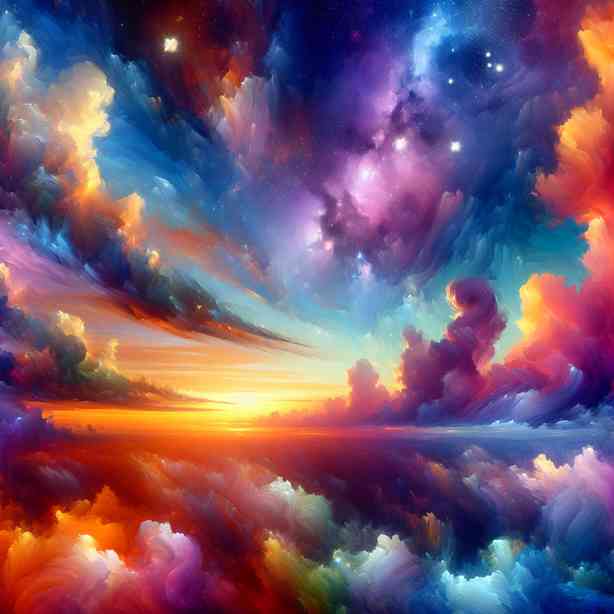
Sky has always been a source of inspiration for artists throughout history. From the tumultuous rainstorms of Turner to the serene expanses of Monet’s water lilies, the sky often plays a pivotal role in conveying emotion and atmosphere within a painting. It is fascinating how artists have learned to capture its ever-changing nature, sometimes evoking more feelings than the actual skies above us.
When we examine a beautiful painting of the sky, we often find ourselves entranced by the colors and compositions that may differ remarkably from reality. This artistic license allows painters to deliver an experience that can be more vivid, more intense, and sometimes even more soothing than what we encounter in everyday life. The emotional impact of a piece of art can resonate deeply, making the sky in the painting feel more alive than the real one.
One of the key elements that make painted skies so compelling is the use of color. Artists have the unique ability to manipulate hues, saturations, and contrasts to evoke certain moods. A sunset, for example, may be depicted in fiery oranges and deep purples. These colors can evoke feelings of warmth, nostalgia, or even longing, which may not fully capture the actual hues seen in nature. The exaggerated colors can serve to amplify an emotional truth that connects deeply with the viewer’s own experiences and feelings.
Texture is another essential factor that contributes to the vitality of a painted sky. Through different brush strokes and techniques, artists can create the illusion of movement, depth, and even emotion. A swirling sky filled with tumultuous clouds brings with it a very different sensation than a calm, still one. Artists like Vincent van Gogh have famously shown us how dynamic paint application can infuse life into the sky, making viewers feel as if they could reach out and touch it. In many cases, the textures found in a painting can make us feel a deeper connection to the artwork, prompting us to reflect on our own relationship with nature.
The composition is equally important in creating a celestial scene that feels alive. The placement of the sky within the broader context of a painting can evoke different feelings and interpretations. In a landscape painting, for instance, an expansive sky can represent freedom and boundless possibilities. On the other hand, a more contained sky may suggest confinement or the need for introspection. By skillfully considering the overall composition, artists can guide viewers’ emotional responses and opinions regarding the landscapes depicted.
Artists often draw inspiration from their surroundings and personal experiences with the sky. The narrative behind a piece of art can profoundly inform how a viewer relates to its painted skies. A sky depicted during a storm might recall unsettling memories for some, while for others, it could represent the cleansing nature of rain and renewal. Context and personal history play significant roles in how we interpret colors, textures, and shapes on canvas. These myriad interpretations highlight the individuality of experiences and memories, emphasizing the power of the painted sky to connect with diverse audiences.
Furthermore, symbolism within artwork often enhances the emotional depth of a painted sky. Specific elements can signify various themes or feelings: dark clouds may symbolize impending trouble or sadness, while bright sunshine might suggest hope or joy. The layers of meaning that one can attribute to a sky can even go beyond the visuals; they can touch upon existential reflections, the passage of time, and human emotion.
The concept of escapism also arises when considering painted skies. Many viewers use art as a means to journey to different worlds or to escape their current reality. An idyllic sky punctuated with fluffy white clouds can transport us to serene landscapes, allowing for a momentary escape from the hustle and bustle of daily life. The ability of art to provide this form of solace cannot be underrated, as it often guides the viewer into contemplative reflection or even acts as a meditative experience.
In contemporary art, the interplay between technology and traditional painting techniques has led to novel expressions of the sky. Digital artists utilize software to create surreal imaginings of skies that are beyond what we experience in the physical realm. These creations can sometimes draw upon the same principles of color, texture, and composition that have been used by traditional artists but can push the boundaries of possibility even further. This newfound accessibility opens up discussions about the meaning of art and perception, further emphasizing how skies can feel more vibrant and alive within a painted context.
For many, immersing themselves in art, particularly those works depicting the sky, becomes a form of therapy. The ability to get lost in layers of color and brushstrokes can induce relaxation and evoke powerful emotions. There’s a distinctive joy that emanates from viewing a painting with a brilliant sky, often leading one to ponder larger questions about existence, nature, and personal connections.
In summary, the sky depicted in paintings often surpasses the beauty of the real sky. Through innovative color use, intricate textures, thoughtful composition, and personal symbolism, artists create works that resonate on an emotional level. The vibrant skies captured on canvas invite viewers to reflect on their feelings, providing an escape and an avenue for contemplation. The dialogue between the painted sky and the observer brings forth an enriched connection that can make those painted skies feel more alive than the real ones.
Ultimately, the painted sky serves as a reminder of the boundless creativity inherent in art and its ability to reflect human experience. Whether calming, exhilarating, or thought-provoking, the skies in paintings continue to inspire and move us, inviting us to linger a bit longer under their imagined expanse. Their vitality reminds us that art not only imitates life but also enhances and transforms it, allowing us to see the world anew through the eyes and palettes of artists.


